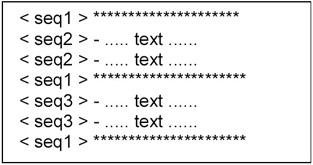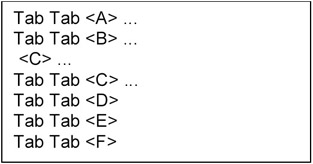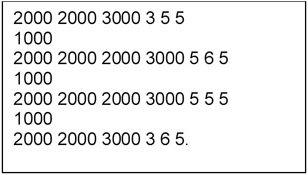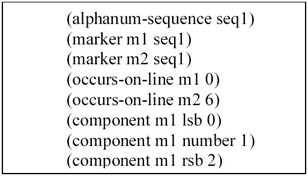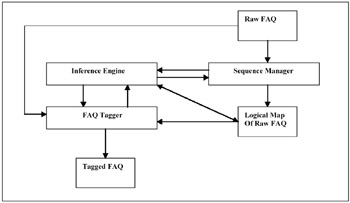MINING FAQS FOR STRUCTURE
The operation of FAQ Finder is based on the assumption that a FAQ is a sequence of Q&A's. In reality, however, the system must first find the Q&A's in the free text of the FAQ. Neither retrieval of answers nor their indexing is possible unless the system knows which text regions are answers and which are questions. One may think that identifying Q&A's is not a serious problem. A typical argument runs as follows. Since questions end in a question mark, it should be possible to use a regular expression matcher that retrieves all of the sentences that end with question marks. There are two flaws with this argument. First, it assumes that one knows how to segment free text into sentences. But, while the identification of sentence boundaries may be feasible in small domains with highly constrained texts, it remains a formidable challenge for free-text processors that go against large heterogeneous corpora (Charniak, 1997; Daniels & Rissland, 1995; Palmer & Hearst, 1994). Second, many questions in FAQs do not end in question marks, while many answers contain questions that do. Thus, even if it were possible to segment free text into sentences, simplistic regular expression approaches are too noisy to be useful (Kulyukin, Hammond, & Burke, 1996).
Exploiting Regularities in FAQ StructureFinding Q&A's would be a serious obstacle, were it not for the fact that FAQs are structured free texts. Consider, for example, the following excerpt from the caffeine FAQ given in Figure 2.
The experts who wrote this FAQ used several lexical cues to mark each Q&A. Each question is marked with two Arabic numerals separated by a dot and followed by a right parenthesis, e.g., "1.2)." Each answer is separated from its question with another lexical cue, i.e., a line of hyphens. We refer to such cues as lexical markers or simply as markers. We have compiled the following list of the most frequent marker types found in FAQs:
Lexical markers are used to introduce structural regularity into FAQs. Structural regularities benefit the experts, i.e., FAQ writers, because they enable easy and fast maintenance of online expertise. They benefit the FAQ readers, because they help them find the needed content quickly.
Marker SequencesLexical markers arrange themselves into marker sequences. For example, "1.1), 1.2)'" is a sequence of two alphanumeric markers, i.e., markers that contain both numbers and characters. The last marker of a sequence is referred to as its head marker. An empty sequence has an empty head marker. When a new marker is added to a sequence, the sequence's head marker is said to be extended by the added marker. For example, the head marker of "1.1), 1.2)," which is "1.2)," can be extended on "1.3)." The presence of these sequences suggests a way to build a FAQ parsing system to mine the free texts of FAQs for structural components, i.e., question-answer pairs, tables of contents, and bibliographies. The parser spots marker sequences that point to structural components and tracks the sequences in the FAQ's text, labeling the elements of the component along the way. The advantage of this approach is that mining for Q&A's requires no deep natural language processing (NLP), which is known to be a very hard task (Allen, 1987). All the parser needs to know is how the marker sequences behave in the FAQs.
Tracking Marker SequencesAn analysis of FAQs reveals that marker sequences obey a small number of constraints. The presence of such constraints is implied by the four assumptions stated in the introduction section. Since FAQ writers are interested in spreading their knowledge, they make sure that the knowledge is packaged in an easily digestible format. The constraints that we have found are as follows:
As an example of the non-recursiveness of marker sequences, consider the following pattern that occurs in numerous FAQs: "[1] [2] [N] [1] " The ellipses stand for pieces of free text. Since marker sequences do not recurse, the FAQ parser knows that a new sequence is started when it sees the second "[1]." This constraint enables the parser to determine when the FAQ's table of contents ends and the actual Q&A sequence begins. As an example of the fixed marker structure constraint, consider "I) II) III) [4] IV) " When the parser detects "I)," it knows that the other markers of the sequence will have the same structure, i.e., a Roman numeral followed by a right parenthesis. Hence, it ignores "[4]" as belonging to another sequence or occurring as part of free text. The stability of marker structure allows the parser to track marker sequences in FAQs. Another example of the fixed marker structure constraint is given in Figure 4, where the tab character is made visible. The parser ignores the first "<C>" marker, because it is not preceded by two tab characters, as are the other markers of the sequence. In other words, the two tabs that constitute the layout of the "<A> <B>" sequence allow us to ignore the first "<C>" marker as belonging to another sequence. As an example of the criss-crossing constraint, consider the sequences in Figure 3. Here the crossing constraint forces the third "-" marker from above to start a new sequence, i.e., seq3. If it belonged to seq2, seq2 would have to cross seq1, which the constraint does not allow.
The proximity constraint simply says that the sequence always extends on the marker closest to its head marker.
Logical Map and LayoutFAQ writers frequently use markers in conjunction with layout. One way to compute the layout of a document is to digitize its text line by line according to a simple encoding scheme. The encoding scheme implemented in FAQ Minder treats each line of a document as a string. Each substring of the string is mapped into the integer denoting its length. The special layout characters like newline, tab, and space are mapped into the integers 1000, 2000, and 3000, respectively. This scheme works well, because all FAQs in our library have lines that are at most 100 characters long. Since the scheme uses only integers, it can be easily adjusted to other document formats with more characters per line. The database of assertions about sequences detected in the text of a document is referred to as the logical map of the document. The presentation pattern of a document is determined by its logical map and its layout. As an example, consider the following chunk of text with the layout characters made visible given in Figure 5. The layout of the above text computed according to the above scheme is given in Figure 6. Part of the logical map of that text is offered in Figure 7. The symbols lsb, rsb and hphn stand for left square bracket, right square bracket, and hyphen, respectively. The predicates used have the following semantics. The predicate (alphanum-sequence s) states that s is an alphanumeric sequence. The predicate (marker m s) states that m is a marker in a sequence s. The predicate (occurs-on-line m n) states that a marker m occurs on line number n. Finally, the predicate (component m c n) states that c is the n-th component of a marker m.
These databases are treated as sets of First-Order Predicate Calculus (FOPC) assertions. This format makes it straightforward to apply standard pattern matching and inference techniques well known in the Artificial Intelligence community (Norvig, 1992).
How FAQ Minder WorksFAQ Minder works in two modes: supervised and unsupervised. In the unsupervised mode, the system takes as input the text of a FAQ and mines it for structure on its own. The system deals with tables of contents, questions and answers, and bibliographies. Network headers and glossaries found at the beginning of many FAQs are not currently dealt with, because the current version of FAQ Finder does not utilize them during answer retrieval. In the supervised mode, FAQ Minder identifies the logical structure of a FAQ by interacting with the user through a set of simple interfaces. Figure 8 shows FAQ Minder's architecture. The system consists of three modules: the sequence manager, the inference engine, and the tagger. The sequence manager reads the text of a document, builds its layout, and activates and deactivates marker sequences. The inference engine manages the logical map and the constraint satisfaction. The operation of the inference engine is based on a set of forward-chaining and backward-chaining rules (Norvig, 1992) about the logical structure of documents and marker constraints. Old rules are adjusted and new rules are added as needed. Thus, documents from new domains can be processed by the system as long as the constraints are encoded as rules.
The tagger inserts tags into the text of the document given the document's layout and logical map. The current tag set consists of six tags: ":QUE," ":ANS," ":TOC," ":TOC-ITEM," ":BIB," ":BIB-ITEM." The ":QUE" tag is put at the beginning and the end of a question. The ":ANS" tag is put at the beginning and end of an answer. The ":TOC" tag is put at the beginning and end of a table of contents. The ":TOC-ITEM" is put at the beginning and end of an item in the table of contents. The ":BIB" and ":BIB-ITEM" tags are used in the same fashion for bibliographies. To prevent any possibility of symbol clashes, the tags are extended with randomly generated sequences of characters and numbers, e.g., ":QUE-a12b34." Once such a sequence is generated, it is appended at the end of each tag used in a given FAQ. FAQs are read line by line. After a line is read, the sequence manager computes its layout, adds it to the document layout, and gives the currently active marker sequence a chance to examine the contents of the line. The manager distinguishes two types of marker sequences: active and inactive. An active sequence is started when a marker is recognized in the text. A sequence remains active as long as any markers found in the read line can extend it. When no found marker can extend the active sequence, it becomes inactive. Thus, there can be at most one active sequence, but potentially many inactive sequences. The inference engine is used heavily by the sequence manager in deciding whether the currently active sequence can be extended on a marker found in the current line. To allow a marker to extend the active sequence, the marker and the sequence must satisfy at least one rule governing extension. For example, one of the backward-chaining sequence extension rules states that a marker extends a sequence if all of the following conditions are satisfied: the marker structure of the sequence's head marker is the same as the marker structure of the found marker; the layout of the sequence's head marker is the same as the layout of the found marker; and the found marker occurs on a line whose number is greater than the line number of the sequence's head marker. In other words, this backward-chaining rule is written as follows:
The <= sign that starts the rule states that this is a backward-chaining rule. All backward-chaining rules have one consequent and at least one antecedent. Each backward-chaining rule has the following syntax: (<= <conseq> <ante1> <ante-n>). The semantics of a backward-chaining rule are that in order to show that the consequent is true, it must be shown that each antecedent is true. The forward-chaining rules are defined in a similar fashion, except that inference proceeds from antecedents to consequents. Each forward-chaining rule has at most one antecedent and at least one consequent, and has the following syntax: (=> <ante> <conseq1> <conseq-n>). The semantics of a forward-chaining rule are that if the antecedent is shown to be true, all of the consequents are asserted in the database. The question mark in front of a symbol states that that symbol is a variable that can have different bindings at run time, i.e., when the rule is applied. For example, in the above backward-chaining rule, the variables ?m and ?s are bound to the name of a marker and the name of a sequence, respectively. At the beginning of the mining process, there are no active or inactive sequences. If a sequence recognizes a marker, it checks if the marker matches the layout of the previously recognized markers. The marker is ignored unless there is a layout match. When the sequence is finished with the line, it sends the sequence manager a message about its findings. If the sequence has recognized a marker and does not violate any constraints(which the inference engine checks against the logical map built thus far), the sequence is permitted to make the marker its current head marker and make the appropriate modifications in the logical map. If a constraint violation is inferred, the sequence manager puts the sequence on the list of inactive sequences. After the active sequences have examined the line and failed, the sequence manager lets the inactive sequences, if there are any, do the same. This second chance heuristic has its empirical justification in the fact that some marker sequences start early in the document, become inactive because of other sequences, and resurface in the middle or at the end of the document. After the layout and the logical map of the document have been computed, the tagger uses them to tag the text of the document. The tagger is allowed to interact with the inference engine, because it may need to do some additional inferences. The end result is the text of the FAQ whose logical components are tagged. FAQ Minder functions as the front-end of FAQ Finder's indexing mechanism. Each FAQ is first mined for its structural components. Once the structural components of the FAQ are found and tagged, the FAQ is given to FAQ Finder for further indexing. The current implementation of FAQ Finder combines scalable, knowledge-intensive NLP techniques with numerical approaches of information retrieval. Thus, each question-answer pair in a tagged FAQ is indexed in terms of its question and its answer. The indexing of questions is done so that at run time FAQ Finder can compute the semantic similarity between the terms in a submitted question and the terms in every question in the FAQ. The statistical similarity is supported through indexing each found Q&A pair as a document in a vector space of Q&A's in a given FAQ.
| |||||||||||||||||||||||||||||||||
| | |||||||||||||||||||||||||||||||||
EAN: 2147483647
Pages: 194


